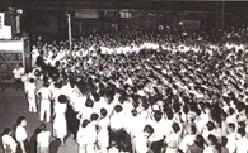
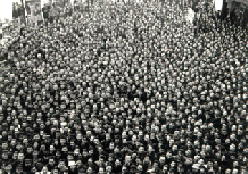
Twenty-seven years of history of the All Japan Pro Wrestling TV program ended when NTV (Nippon Television / Channel 4) televised the final program at 1:45 a.m. Thursday, June 22, 2000. This week's View From The Rising Sun will look at the early days of television Puroresu here in Japan.
On Wednesday, August 15, 1945, an exhausted and battle-weary Japan accepted the surrender terms of the Allied powers, and, by imperial edict, the people laid down their arms. For more than six years after the surrender, Japan was placed under Allied, mainly American, control. Under the Occupation authorities, led by General Douglas MacArthur, various social and political reforms were carried out. The first TV broadcast in Japan was from JOAK-TV-NHK (Japan Broadcasting Corporation / Channel 1) television studios in Tokyo at 2:00 p.m. Sunday, February 1, 1953. It was the semi-governmental broadcasting network in Japan. On the other hand, the founder of NTV, Matsutaro Shoriki, was determined to lift the solemn spirits of a society coping with omnipresent devastation following World War II. Television became his method of realizing that goal. Shoriki set up TV sets for people who couldn't afford television on street corners in 42 locations around the Tokyo area. NTV had its first broadcast at 11:20 a.m. Friday, August 28, 1953.
The first pro wrestling show in Japan was held at the Ryogoku Memorial Hall (old Sumo Hall) in Tokyo on Sunday, September 30, 1951. Joe Louis (former World Heavyweight Boxing champion) and seven wrestlers (including Bobby Bruns from Iowa and Harold Sakata [a.k.a. Toshi Togo / Odd-Job from the James Bond 007 movie Goldfinger] from Hawaii) were invited by the Torii Oasis Shriner's Club. They had wrestling shows in Tokyo for two months until November to entertain U.S. servicemen during the Korean War (1950-1953). Rikidozan, real name Mitsuhiro Momota, who quit as a Sumo wrestler the year before, started training to be a pro wrestler, and he had his very first match against his trainer, Bobby Bruns, at the Ryogoku Memorial Hall on Sunday, October 28, 1951 (10 minutes time up draw).


Rikidozan founded Nippon Puroresu Kogyo (JWA [Japan Pro Wrestling Alliance]) on Thursday, July 30, 1953. JWA was the first full-time professional wrestling company here in Japan, and they had three shows at Kuramae Kokugikan (old Sumo Hall) from Friday, February 19 to Sunday, February 21, 1954. The first show was aired by both NHK and NTV. NTV also aired the second and third shows. Rikidozan carried the irresistible Puroresu boom at the daybreak of television. There were thousands of people gathered just to watch their hero, Rikidozan, and his "Karate Chop" beat gaijin (foreign) wrestlers on the "Street TV sets" that NTV set up for people.
NHK and NTV (7:30 - 9:00 p.m. / Friday, February 19, 1954)
February 19, 1954 (6:00 p.m.)---Kuramae Kokugikan (Sumo Hall), Tokyo (Live TV)
Rikidozan & Masahiko Kimura drew Ben & Mike Sharpe (1-1)
(1) Rikidozan beat Mike (14:15)
(2) Mike beat Kimura (8:20)
(3) 61 minutes time up draw
NTV (8:00 - 9:00 p.m. / Saturday, February 20, 1954)
February 20, 1954---Kuramae Kokugikan (Sumo Hall), Tokyo (Live TV)
Rikidozan beat Ben Sharpe (2-1)
NTV (3:00 - 5:00 p.m. / Sunday, February 21, 1954)
February 21, 1954---Kuramae Kokugikan (Sumo Hall), Tokyo (Live TV)
World Tag Team title match
Ben & Mike Sharpe drew Rikidozan & Masahiko Kimura (1-1)
(1) Mike beat Kimura (24:57)
(2) Rikidozan beat Mike (55 seconds)
(3) Double countout---Sharpe Brothers kept the title
NTV had drawn an over 60% TV rating with Rikidozan Puroresu's popularity in those days. Rikidozan brought in the NWA World Heavyweight champion, Lou Thesz, for the first time from October 7 to 25, 1957. JWA also held the first World League round-robin tournament from May 21 to June 15, 1959.
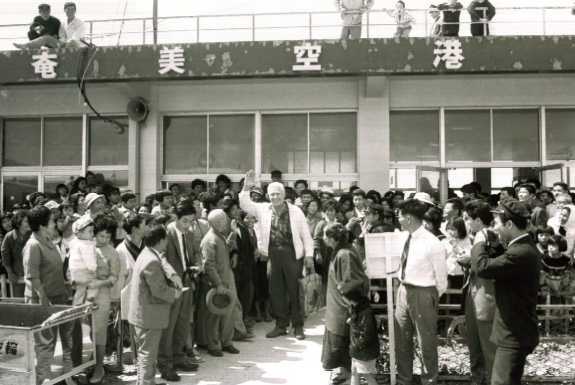
However, the WWA World Heavyweight title match between Rikidozan and Freddie Blassie at Tokyo Gym on Monday, April 23, 1962 (special live TV) and a six-man tag team match between Rikidozan, Toyonobori, & Great Togo and Lou Thesz, Freddie Blassie, & Mike Sharpe (Sr.) at Ohji Gym in Kobe City on Friday, April 27, 1962 (Live TV) caused heart attack deaths from shock to a total of eleven aged persons, who were watching the match on TV, for a week.
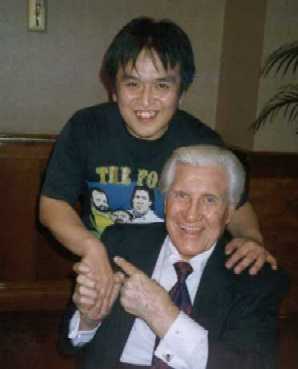
NTV purchased many wrestling tapes from the USA and televised USA Pro Wrestling in 1954. By the way, Colour Television sets (Toshiba, Hitachi, Mitsubishi) were priced at around $4,000 to $5,000 in Japan 40 years ago (July 1960).
Rikidozan, 39 years old, was stabbed by "yakuza" (Japanese Mafia) in a nightclub in Akasaka, Tokyo on Sunday, December 8, 1963, and he died one week later. JWA had still enjoyed huge success with Giant Baba, Antonio Inoki, Kintaro Ohki (Kim ILL), Seiji Sakaguchi, etc., in the 1960's - 1970's.
TBS (Tokyo Broadcasting System / Channel 6) started TBS Puroresu (Isao Yoshihara's IWE [International Wrestling Enterprise]) for the first time at 7:00 p.m. Wednesday, January 3, 1968. TBS aired IWE until Saturday, March 30, 1974.
January 3, 1968---Nichidai Kodo, Tokyo (Live TV)---28.8% (Nielsen Research)
TWWA (Trans World Wrestling Association) World Heavyweight title match
Lou Thesz beat Great Kusatsu (Sr.) (2-0)
(1) Thesz beat Kusatsu (17:50)
(2) Kusatsu swooned by Thesz' Back Drop Suplex---Thesz kept the title
JWA and NTV went head-to-head against rival TBS. The International Heavyweight title match between Giant Baba and Crusher Lisowski was held at Kuramae Kokugikan (Sumo Hall, less than 30 minutes from Nichidai-kodo). They drew a 34.7% TV rating (Nielsen Research). A total of 63.5% of television viewers watched Puroresu on the day. How popular Puroresu was here in Japan in those days!
NET (Nippon Education Television, now TV Asahi / Channel 10) wedged in, airing JWA shows. They pushed Antonio Inoki as a drawing card, while NTV kept exclusive possession to televise Giant Baba's match. NET aired JWA for the first time at 9:00 p.m. on Wednesday, July 2, 1969.
June 23, 1969---Ota Ward Gym, Tokyo (Taping)
Antonio Inoki & Michiaki Yoshimura beat Kurt & Karl Von Steiger (2-1)
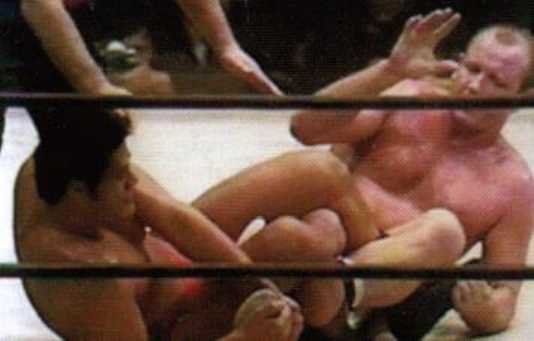
JWA's heads abandoned their company to dissipation. They ended their 20-year history after losing their two biggest stars, Baba and Inoki, when JWA had their last show at Yoshii Town Gym in Gumma on Friday, April 20, 1973. NTV terminated 18 years of history of the program on May 12, 1972, after JWA accorded permission to NET to televise Baba's match. NET aired the final program of JWA on Friday, March 30, 1972 (taped match, United Heavyweight title match between Akihisa Takachiho [The Great Kabuki] and Johnny Valentine at Sano Civic Hall, Gumma on March 8).
Antonio Inoki and New Japan Pro Wrestling had their first show at Ota Ward Gym in Tokyo on Monday, March 6, 1972. Karl Gotch beat Inoki (15:40) in a main event.
Tokyo 12 Channel (now TV Tokyo / Channel 12) aired the World Heavyweight title matches between Gotch and Inoki as a special program at 10:30 p.m. Wednesday, October 4, 1972.
October 4, 1972---Kuramae Kokugikan (Sumo Hall), Tokyo (Taping)
World Heavyweight title match
Antonio Inoki beat Karl Gotch (27:16 countout)---Inoki won the title
As the smallest of six key TV stations in Tokyo, Tokyo 12 Channel pushed American sports and entertainment like Roller Derby and woman wrestling in the 1960's. They had drawn a 22.4% TV rating with Fabulous Moolah's WWWF Women's World title match at 7:30 p.m. Thursday, November 1968. They had purchased wrestling tapes from Pedro Martinez in Buffalo, New York and Great Togo in Los Angeles, California. Then, they had an American pro wrestling program named "Puroresu Hour" at 8:00 p.m. every Saturday from November 30, 1968 to September 30, 1972. They televised matches from the Buffalo area and Madison Square Garden. Now, TV Tokyo is still the smallest one of six, but they made a great success with Pokemon.
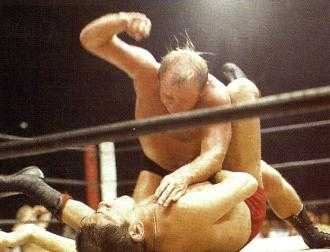
Giant Baba and All Japan Pro Wrestling had their first show at Machida City Gym in Tokyo on Saturday, October 21, 1972. Bruno Sammartino & Terry Funk beat Baba & Thunder Sugiyama in a main event. NTV televised special programs featuring Baba vs. The Sheik (International Center, Honolulu, Hawaii on September 20) at 8:00 p.m. Saturday, October 7, 1972, and Baba vs. the masked Professional (Harley Race) (Amarillo, Texas on September 22) on October 14, 1972 to hype the new All Japan Pro Wrestling program on October 21, 1972.
October 21, 1972---Machida City Gym, Tokyo (Live TV)
Bruno Sammartino & Terry Funk beat Giant Baba & Thunder Sugiyama (2-1)
(1) Terry beat Sugiyama (13:00)
(2) Sugiyama beat Terry (9:03)
(3) Bruno & Terry beat Baba & Sugiyama (7:44 countout)
NET (now TV Asahi / Channel 10) started the regular program "World Pro Wrestling," from New Japan Pro Wrestling, at 8:00 p.m. Friday, April 6, 1973.
April 6, 1973---Tochigi Prefecture Sports Center, Utsunomiya City (Live TV)
Antonio Inoki & Seiji Sakaguchi beat Jan Wilkins & Cyclone Manuel Soto (2-1)
(1) Inoki beat Wilkins (13:27)
(2) Wilkins beat Sakaguchi (4:56)
(3) Inoki beat Wilkins (9:40)
Tokyo 12 Channel (now TV Tokyo / Channel 12) started a regular program of Isao Yoshihara's IWE (International Wrestling Enterprise) at 8:00 p.m. Monday, September 23, 1974. They aired until IWE folded in 1981. IWE had strong relationships with the AWA and Stampede Wrestling in the 1970's and appealed to us with a great many cage death matches.
September 23, 1974---Nichidai-Kodo, Tokyo (Live TV)
Rusher Kimura & Great Kusatsu beat Superstar Billy Graham & Baron Von Raschke (2-1)
(1) Kusatsu beat Raschke (15:40)
(2) Graham beat Kusatsu (6:50)
(3) Kimura & Kusatsu beat Graham & Raschke (1:16 disqualification)
Puroresu has been a very unique spectator sport since its start here in Japan. Gaijin (foreign) wrestlers were simply designed as "big, tall, tough bad guys" in the position of being hated against the Japanese hero, Rikidozan. Japanese had the deep inferiority complex as a defeated nation after World War II. Then, Japanese people could beat their frustrations and satisfy their wants when Rikidozan karate-chopped much bigger villainous gaijins. In the early 1960's - 1980's, the rise of Japan's economic strength totally cleared Japan's complex. In the 1990's, CATV and satellite TV have come into wide viewing in Japan, and we can watch the WWF and WCW's scene on time. In the 2000's, the Digital TV era has just started. Today, the economic situation in Japan remains serious, and the nation faces a host of social problems. Puroresu and pro wrestlers themselves have kept pace with the times; also, Puroresu and TV programs have kept changing with them, but their essential meaning is to give us feelings and tremblings of joy and excitement like thousands of people felt in front of the "Street TV sets" over 40 years ago.
Please address all questions and comments about Japanese wrestling to Masanori at
|
![]()

The Way It Was | View From The Rising Sun | The Way I See It
SMW Tribute | WCW/WWF Satire | Rob's Photos
Wrestling Links | Sign Guestbook | View Guestbook

E-mail messages are ALWAYS welcome at smokyrobmoore@bigfoot.com
This page hosted by ![]() Get your own Free Home Page
Get your own Free Home Page